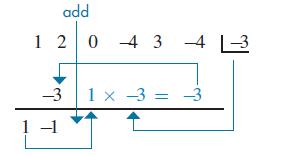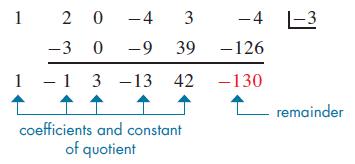Question: In Example 6, change the x + 3 to x + 2 and then perform the synthetic division. Data from Example 6 Divide x 5
In Example 6, change the x + 3 to x + 2 and then perform the synthetic division.
Data from Example 6
Divide x5 + 2x4 − 4x2 + 3x − 4 by x + 3 using synthetic division.
Because the powers of x are in descending order, write down the coefficients of f(x). In doing so, we must be certain to include a zero for the missing x 3 term. Next, note that the divisor is x + 3, which means that r = −3. The −3 is placed to the right. This gives us a top line of
![]()
Next, we carry the left coefficient, 1, to the bottom line and multiply it by r, −3, placing the product, −3, in the middle line under the second coefficient, 2. We then add the 2 and the −3 and place the result, −1, below. This gives

Now, multiply the −1 by −3(= r) and place the result, 3, in the middle line under the zero. Now, add and continue the process, obtaining the following result:

Because the degree of the dividend is 5, the degree of the quotient is 4. This means that the quotient is x4 − x3 + 3x2 − 13x + 42 and the remainder is −130. In turn, this means that for f(x) = x5 + 2x4 − 4x2 + 3x − 4, we have f(−3) = −130.
coefficients 1 2 0 4 3 -4 -3 -r
Step by Step Solution
3.36 Rating (165 Votes )
There are 3 Steps involved in it
To change the x 3 to x 2 in Example 6 and then perform the synthetic division we just need ... View full answer

Get step-by-step solutions from verified subject matter experts


